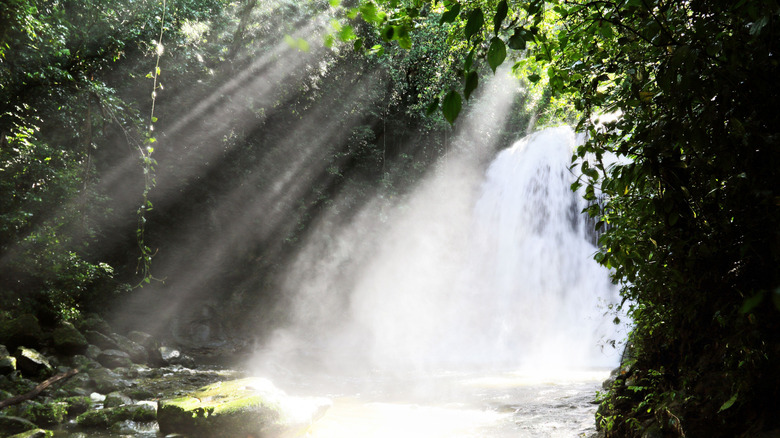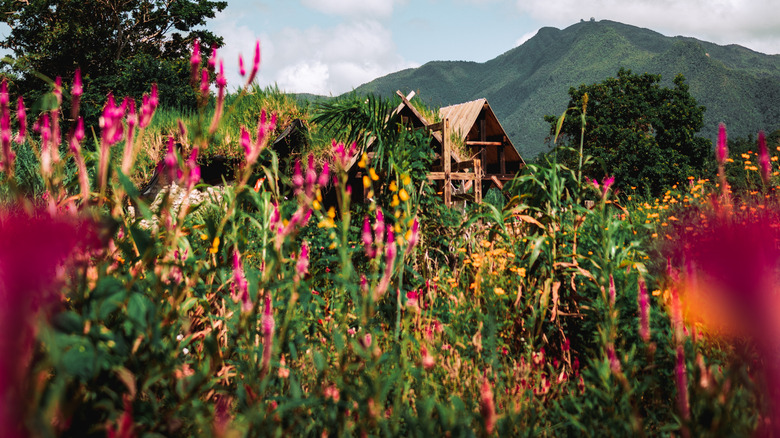'Puerto Rico's Garden' Is A Gorgeous Inland Island Destination With Verdant Cliffs And Waterfalls
Puerto Rico, also known by its nickname of the "Island of Enchantment," is a magical place where the rivers and lakes glisten under the Caribbean sun. The waters of this island — like this lagoon that is a bioluminescent gem brimming with sea turtles and manatees — have long called to be found and explored by the adventurous. Puerto Rico's mountains also hide plenty of unique places to see including a wildly underrated town with no crowds and ancient beauty as well as a small town called Aibonito that is fondly known as "Puerto Rico's Garden."
Conveniently located about an hour from Ponce on the southern side of the islands and 90 minutes from San Juan in the north, Aibonito is a must-see place to sneak in between your beach and lagoon adventures. The summer is the best time to visit this vibrant garden of a town because this is when Aibonito comes to life with the annual Festival de las Flores (Flower Festival). The festival runs for nine or ten days and entrance costs around $7 per person during the week, $8 on the weekends, with kids under 12 getting in for $3 (at the time of this writing). As you walk amongst zinc-roofed houses and the Plaza de Recreo, the smell of flowers, succulents, and fruits will waft towards you. You'll also hear lively music and the sound of vendors hawking their artisanal items and gardening accessories. Plus, on top of the charm of the town itself, Aibonito is also surrounded by natural wonders.
Follow a river to majestic waterfalls in Aibonito
A mere 25-minute drive northeast from Aibonito is a canyon 5.6 miles long that teems with over 700 species of flora and wildlife. Cañón de San Cristóbal (Saint Christopher's Canyon) was named as one of Puerto Rico's top 10 wonders, part of that in thanks to the waterfall la Niebla del Usabón. This impressive waterfall is 240-feet-tall, making it one of the largest on the island. Exploring the canyon takes a bit of hiking, as its bottom is around 500 feet deep. It is highly recommended to do the trek accompanied by a tour guide or expert hikers who are skilled in rappelling, and can supply safety equipment like helmets and ropes.
Once you make it to the bottom, you'll be met by the river that carved out this masterpiece, the Usabón River. Following the river leads you to the main attraction of Cañón de San Cristóbal, the waterfalls. First you'll spot the aforementioned La Niebla that will crash down the verdant cliffs around you, welcoming you to bathe in the pools at its feet. The river then leads you to another falls, called Salto de la Cabra (the Goat Jump). If you're traveling with a tour guide with rappelling equipment, you can slowly make your way down the 30-foot-tall falls. You might even get to climb back up after. For those that are not inclined to climb a waterfall, there is a moderate trail in the park that stays on the rim of the canyon and allows you to enjoy the falls from a distance.
Experience Puerto Rico like a local
Cañón de San Cristóbal teems with vibrant flora, including more than half of Puerto Rico's bird species. Thanks to the conservation efforts of Para La Naturaleza — an environmental non-profit — the canyon is a protected area. A good thing, too, because from 1954 to 1976, the canyon was unfortunately used as a landfill. Some plant species found in the canyon have been listed as endangered by the U.S. Endangered Species Act, a gentle reminder how we can be mindful in protecting the environments we visit.
Since Puerto Rico is a relatively smaller island, you can easily stay in either San Juan or Ponce and be within driving distance of Aibonito and the Cañón de San Cristóbal. Old San Juan is a picturesque neighborhood to stay in. The buildings retain their colonial architecture, and locals are happy to host guests who want to walk through the neighborhood's cobblestone streets. Ponce to the south has resorts lining beautiful, sandy beaches. Stopping by in the summer is the best time to visit Puerto Rico, Aibonito, and the neighboring canyon. The summer also gives you a chance to explore one of Puerto Rico's most underrated beaches.
While traveling between destinations, make sure to check out the lechón eateries you'll find on the side of the highways. Lechón is Spanish for roasted whole pig, but the word is synonymous with eateries where you can order food buffet-style. Order pork, arroz con gandules, mofongo, morcilla, or just about any Puerto Rican dish that'll make you feel like you're eating like a local.


